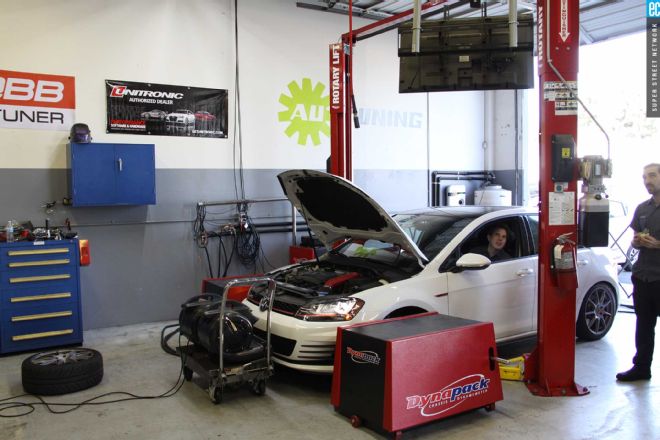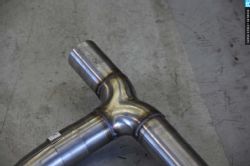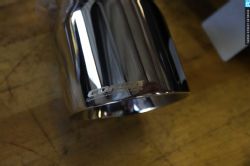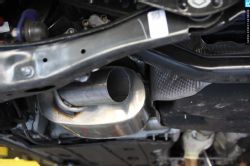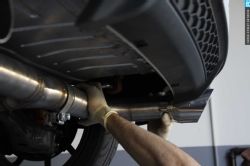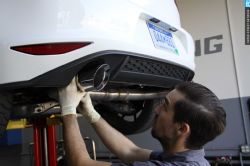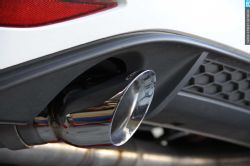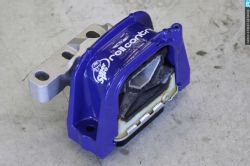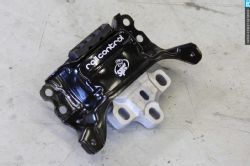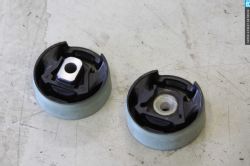I was one of the first eight or so Americans to drive the MK7 GTI back in April 2013. Volkswagen invited us to the South of France to test out the car on twisty mountain roads and motorways. The car was so good; I wondered if there was a point for a Golf R and had immediate concerns for the aftermarket. Right out of the box, the MK7 is better than most tuned MK6s. When I received this long-term car from VW, I wondered how much improvement I could actually make. I'm happy to say, we've taken it to another level.
The first power-adder we tested was the Neuspeed Power Module. It makes a legitimate difference everywhere on the tach and better yet, is easily reversible and affordable. We felt a pretty decent improvement in the seat of the pants. Those feelings were backed up by a Mustang dyno test. For this update, we decided to try a software flash from Unitronic and a cat-back exhaust from Corsa Performance. While we were at AUTuning, we also installed new engine mounts from SuperPro. Before we uninstalled the power module, we thought a couple of dyno pulls would be a good idea on the Dynapack we were using this time.
Let's start off by looking at baseline numbers. Volkswagen rates our '15 GTI Performance Package car at 220 hp and 258 lb-ft of torque. Predictable numbers if we look back at the numbers of past GTIs, but lagging behind cars like the 252hp and 270-lb-ft Ford Focus ST. Once it was on the dyno, however, you can see why the Ford isn't any faster than the GTI.
A few pulls showed typical German modesty with our P-flo and cat-back-equipped GTI measuring 225 hp and 262 lb-ft of torque at the wheel. Both modifications, while adding a better soundtrack, make very little performance difference on an otherwise stock engine. These numbers are right in line with other stock cars we've seen tested on Dynapack dynos. Long story short, the car is making more power and torque at the wheels than what VW is saying it makes at the crank. I'm not a believer in standard percentages for estimating crank power based on wheel horsepower, so let's just agree that GTIs are exceptionally underrated from the factory. Lastly, keep in mind that all of this is being done on 91-octane California pump gas, which is commonly believed to be the worst gas in the country.
The Neuspeed Power Module manipulates the car's sensors that monitor boost pressure inside the induction system. No other signals are changed, so no other parameters will change, either. A quick look at the dyno plot shows that adding boost takes the stock torque curve and simply pushes it up the graph. Gains from the power module resulted in a jump to 248 hp. There is a spike right in the beginning of the torque curve, which is more an anomaly of dyno testing than actual torque development, but you can still see the big gains available from a device that is so affordable and easy to install and maybe more importantly, protects your warranty by being so easy to uninstall.
Software tuning is a more involved process requiring reflashing the car's engine control unit, but if you're reading this, you know all about it. Obviously, getting into the ECU gives tuners the opportunity to change more than just boost. Timing and fueling changes allow more control, so in theory, allow the tuner to free up far more power than a stand-alone module. We decided to try a flash from Unitronic. Since we didn't change out the factory downpipe, we used a Stage 1 flash, but while we were at it, we also did the DSG Flash.
The Stage 1 Flash has a retail price of $650 while the Stage 1 DSG Flash retails for $600. Unitronic claims 297 hp and 346 lb-ft at the crank. Our car, after both flashes with the same intake and exhaust, same dyno, and same day made 262 hp and 298 lb-ft at the wheels. The numbers look pretty good, but I wasn't satisfied stopping there.
When possible, I subject cars to the same battery of testing I used during my time at Motor Trend. So out to Autoclub Speedway in Fontana, California, I headed for a day of instrumented acceleration, braking, and handling tests.
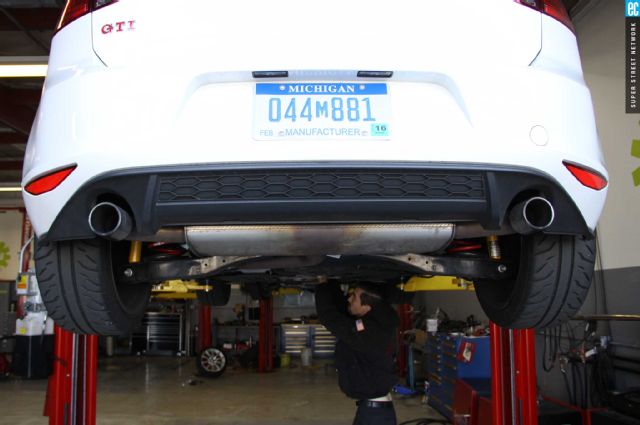 | 2015 Vw Gti Project Car
| 2015 Vw Gti Project Car
In the past, I've noted the problem with getting 0-60-mph times on the GTI. Even with the car assuring me traction control is disabled, it still cuts power at the slightest hint of wheelspin. Inevitably, there is wheelspin in First gear, even with stock power. From the factory, a 6.0-second 0-60-mph time is the best I've ever gotten. It always cuts throttle somewhere in First gear and then the car has to build boost again and continue accelerating. Adding torque didn't help the situation, and adding stickier tires helped but not as much as I would have liked. However, even with the bobble in First gear, we were able to drop our 0-60-mph time down to 5.7 seconds. To put that into perspective, that's still a second slower than a Golf R. However, buying a front-wheel-drive car for 0-60 times is like buying bowling shoes for jogging.
In the quarter-mile, which again I present just as scientific evidence of added power, it dropped from a 14.6-second elapsed time down to 14.1 seconds. That half-second isn't the most impressive thing. The GTI's trap speed went from 98.0 mph all the way up to 104.0 mph. For those wondering, the last Golf R I tested did 104.9 mph at that very same testing location. It is possible that if we were to deactivate the traction control entirely by either disabling it through the OBDII port with a scan tool, or through more manual means such as pulling a fuse, we would likely be able to shave time off these already satisfying numbers.
Figure-8 testing is where things really got interesting. Let's look at everything on the car up until now. Besides the Unitronic flashes, Corsa exhaust, Neupseed P-flo, and SuperPro engine mounts, we had previously installed H&R coilovers, H&R front and rear antiroll bars, SuperPro front lower control arms and rear toe-link arm bushings, OZ Omnia wheels, and Bridgestone RE71-R tires in the factory size of 225/40-18.
First, as previously pointed out, the SuperPro arms make a huge difference in steering feel, turn-in, and accuracy. The H&R components reduce body roll and the Bridgestones on the OZ wheels have definitely added a decent amount of grip. While the difference in feel is substantial on the road, the difference on the test track is incredible. Just a few laps cemented my belief that road driving can rarely give you the whole picture of how a car behaves.
For the hard numbers, a stock GTI laps our figure-8 in 25.5 seconds with an average 0.76 g in the whole lap. A stock Golf R does a 24.9-second lap, averaging 0.84 g. Both cars pull a maximum of 0.94 g in pure lateral acceleration. Our GTI now turns a lap of 24.3 seconds with an average of 0.90 g, but pulling a maximum lateral of 1.01 g. Cornering speeds were obviously much higher, braking numbers were better than the stock, but our front-wheel-drive GTI just won't get out of the corners quite as fast as the R putting power to all four wheels. With that said, the balance of the GTI is now much better. The car is far more neutral and the back end will rotate around with a little lift-throttle. It's still possible to light up the front tires, but the Unitronic software gives plenty of modulation at part-throttle. Kim Reynolds, Motor Trend's testing director, walked away from GTI impressed with the amount of overall grip and performance from the utilitarian hatchback. It now has the figure-8 lap time of an e90 M3. Not too bad for some simple bolt-ons.
Corsa Performance Exhaust
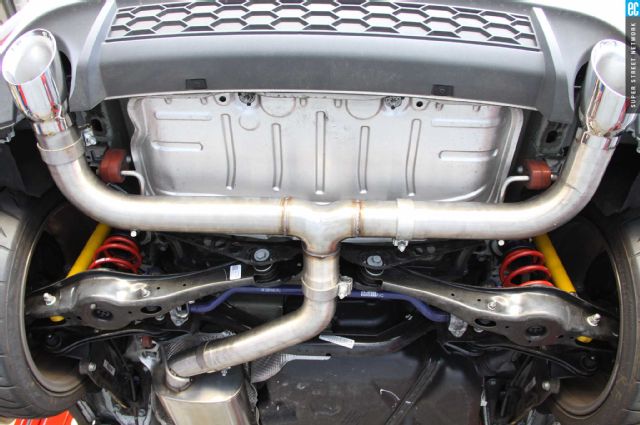 | 2015 Vw Gti Project Corsa Performance Exhaust Muffler
| 2015 Vw Gti Project Corsa Performance Exhaust Muffler
Most exhaust systems, the factory included, use mechanical packing material like steel wool to absorb noise in the exhaust system. Corsa Performance uses RSC, reflective sound cancelation, instead to decrease noise levels and nearly eliminate certain frequencies. The idea is that by creating a cavity that is a quarter the length of the sound wave, when it enters and then bounces back, it has now traveled half the length of the wave—making it 180 degrees out of phase, which cancels the original wave. Different sized chambers within the mufflers can eliminate different frequencies that we find most annoying.
The Sport system on our car is slightly louder than factory at idle with a deeper, slightly coarser tone, but at higher throttle levels and rpm, it really opens up. We went with polished stainless tips, but Corsa also offers black tips for a more conservative look. In the beginning, I was a little hesitant to put an exhaust on the GTI. My 3-year-old is in the back seat just about every day, so sound comfort is a main priority. In normal driving, the difference in tone is obvious, but an increase in sound level isn't. When the car is in Sport Mode, the shifting "pops" from the DSG are louder and it sounds more like a GTI should. Some of the younger guys around the office don't think it's quite loud enough; if we were to add a downpipe, I'm sure it would be. For right now, however, I'm completely happy with the Corsa's results.
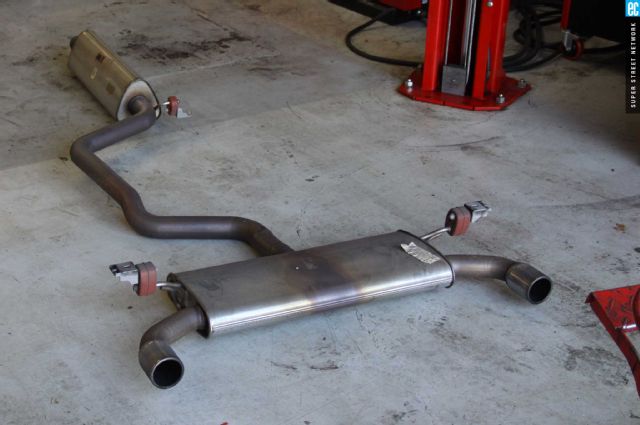 | The factory exhaust is a quality piece with good flow characteristics. The majority of the backpressure bottleneck is in the catalytic convertors, so without a downpipe, it will be tough to see big gains. The sound, however, is much improved.
| The factory exhaust is a quality piece with good flow characteristics. The majority of the backpressure bottleneck is in the catalytic convertors, so without a downpipe, it will be tough to see big gains. The sound, however, is much improved.
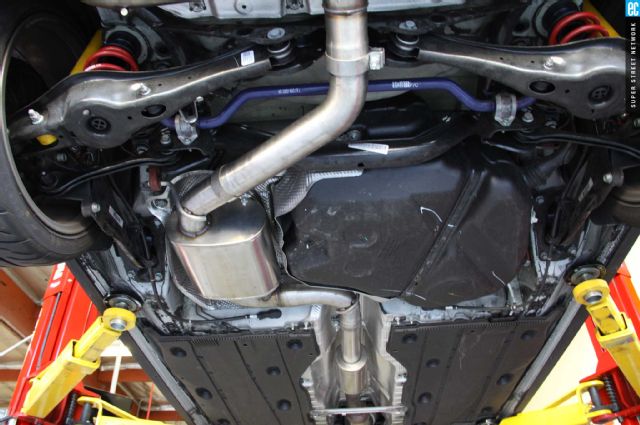 | 2015 Vw Gti Project Corsa Performance Exhaust
| 2015 Vw Gti Project Corsa Performance Exhaust
SuperPro MQB R4 Engine Mounts
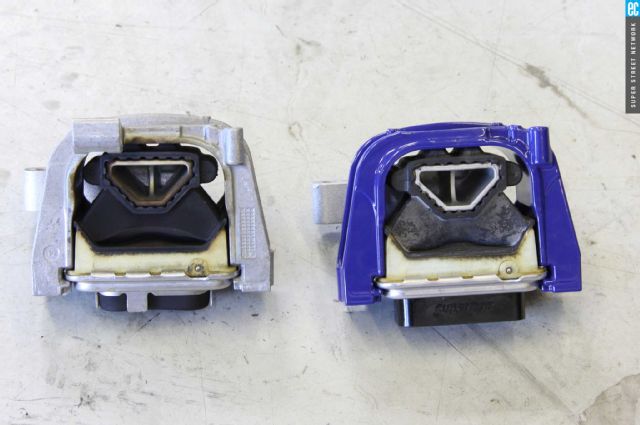 | 2015 Vw Gti Project Superpro Mqb R4 Engine Mounts
| 2015 Vw Gti Project Superpro Mqb R4 Engine Mounts
Engine mounts are an often undervalued and overlooked performance product. This is another product I was a bit hesitant to add to the GTI. I've had polyurethane mounts on several cars in the past and normally I've uninstalled them after anywhere from a couple of months to as little as a couple of hours because of the added vibration and noise. SuperPro has taken a different route with these mounts, using a stiffer, rubber-like Polyelast material than factory rather than polyurethane.
SuperPro has them manufactured to the original part’s exact dimensions, fit, and finish so they install just like stock. If they weren't powdercoated a different color, you'd have a tough time telling them apart. Installation of the engine and transmission mounts is relatively quick and easy. The lower dog-bone mount requires the subframe to be removed so the two cylindrical mounts can be pressed in. Anytime the subframe is removed, an alignment is necessary. The results of the mounts are far less movement of the drivetrain. This not only means more power makes it to the road, but also reduces the inherent problems associated with the drivetrain's mass shifting around. Have a couple of your 250-pound friends jump up and down in the back seat while you're driving to see what I mean.
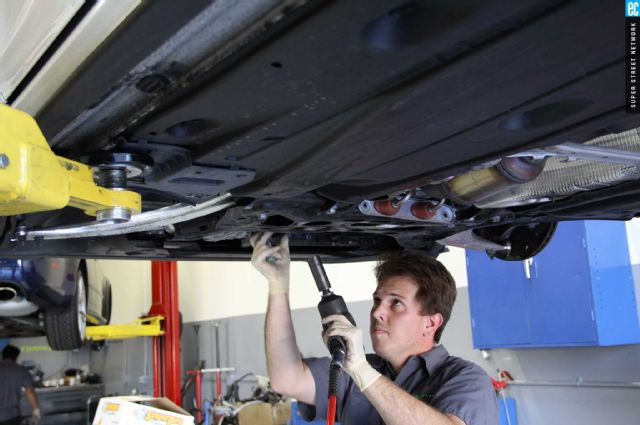 | 2015 Vw Gti Project Superpro Mqb R4 Engine Mounts Install
| 2015 Vw Gti Project Superpro Mqb R4 Engine Mounts Install
Powertrain vibration and noise are slightly higher than stock. The noise is similar to adding a single-mass flywheel to a late-model car. The extra vibration hasn't been noticeable by anyone else who has ridden in or driven the car. I can tell it's there, but maybe that's because I'm looking for it. The advantage of the mounts is most obvious watching the engine while the car's on the dyno. With the stock mounts, the engine moves a couple of inches on shifts as it unloads and loads. It's a fraction of an inch with the SuperPro mounts. The mounts sell for roughly $900 a set, so they aren't cheap, but if you really want a performance gain, with no downside in comfort, these are the way to go.
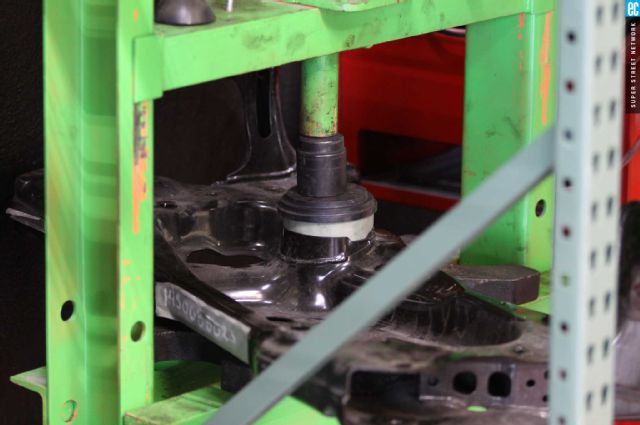 | 2015 Vw Gti Project Superpro Mqb R4 Engine Mounts
| 2015 Vw Gti Project Superpro Mqb R4 Engine Mounts
Unitronic Stage 1 ECU and DSG Flash
The accompanying dyno charts will mostly speak for themselves. Besides the additional power, the other notable attribute of the flash compared to stock and even the Neuspeed Power Module is the way horsepower doesn't fall off after 4,600 rpm.
Around town, the flashed car retains all the stock driveability without any of the surging associated with some other flashes. Fuel economy hasn't changed enough to notice, but power certainly has. The DSG Flash is tough to recognize. In normal mode, there is almost no perceptible difference. In Sport Mode, shifts do seem slightly faster, although stock is so fast, it would be tough to tell. Wide-open throttle shifts are where it seems to matter most. The car cracks off shifts at impossible speeds.
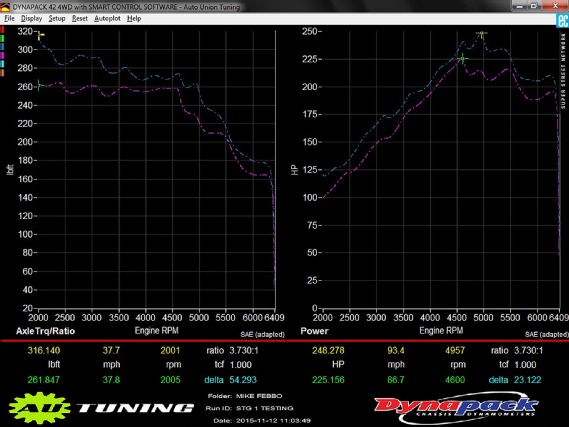 | The Neuspeed Performance Module increases torque everywhere in the powerband. It's easy to install and makes a big change for the price. If you don't want to commit to a flash, an intercept module is a great alternative.
| The Neuspeed Performance Module increases torque everywhere in the powerband. It's easy to install and makes a big change for the price. If you don't want to commit to a flash, an intercept module is a great alternative.
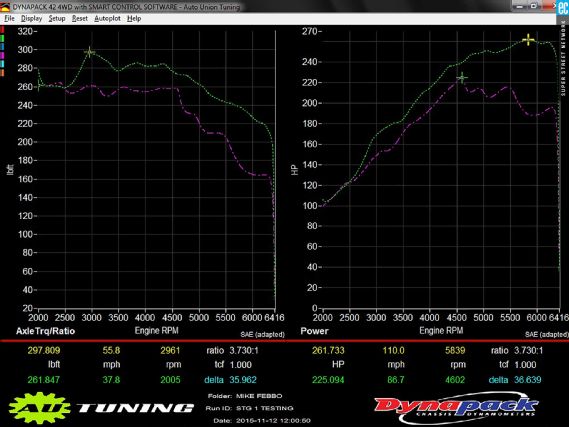 | The big gains are obvious, but the real story is that power keeps going at the high end. In a stock car, the show's over by 4,600 rpm, but with the Unitronic Flash, it keeps pulling right to redline.
| The big gains are obvious, but the real story is that power keeps going at the high end. In a stock car, the show's over by 4,600 rpm, but with the Unitronic Flash, it keeps pulling right to redline.
Spoiler Alert - All-Weather Grip
Our Bridgestones might be just about the best summer tire we've tried, but sunny Southern California is on the verge of what is reported to be the worst El Nino season on record. That means rain—and a lot of it. Continental Tires has supplied its latest in all-season, the ExtremeContact DWS.
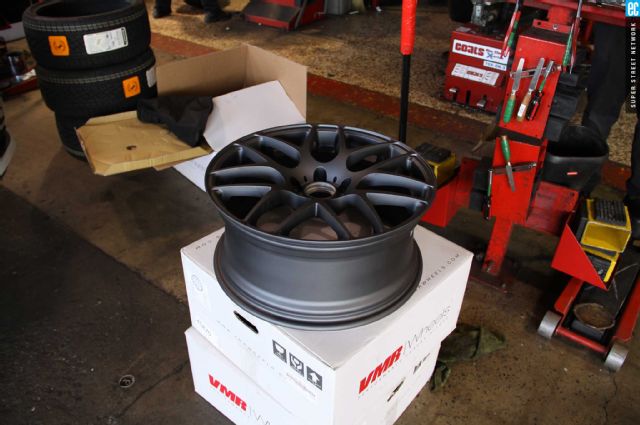 | 2015 Vw Gti Project Vmr V710ff Wheel
| 2015 Vw Gti Project Vmr V710ff Wheel
We couldn't possibly put these new tires on the same old wheels, especially since we decided to step up to 19-inch wheels. VMR Wheels, located down the street in Anaheim, has a new line of lightweight, high-performance flow-formed wheels. We chose the V710FF, a classic mesh design finished in matte graphite.
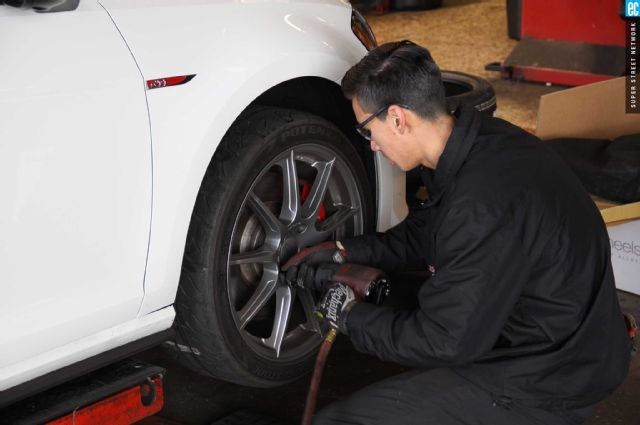 | 2015 Vw Gti Project Vmr V710ff Wheel Mounting
| 2015 Vw Gti Project Vmr V710ff Wheel Mounting

